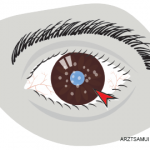The process included use of a methodology called Grading of Recommendations Assessment, Development and Evaluation (GRADE), which was used to rate the quality of available evidence as high, moderate, low or very low, relative to the patient/population, intervention, comparison and outcomes (PICO) questions the team derived.
“The main advantage [of GRADE] over the RAND methodology, used previously, is that it standardizes the process of moving from evidence to recommendations, leading to greater transparency around the process,” says Sarah Ringold, MD, MS, assistant professor of rheumatology at Seattle Children’s Hospital and a co-author of the guideline. Dr. Ringold also led the development of a new guideline for other aspects of JIA, including polyarthritis, sacroiliitis and enthesitis.3,4
Ophthalmic Monitoring
Among the strongest recommendations in the new JIA-associated uveitis guideline are those that involve ophthalmic monitoring of patients with JIA, particularly those at risk of developing or already diagnosed with uveitis. This, the authors say, is because the high risk of ocular complications that can lead to vision loss is high, but the risk of complications from ophthalmic exams is low.
These recommendations are included despite the fact that frequent monitoring can create strain for families.
“The treatment of the disease is often a bigger stressor for children than the disease itself,” says Dr. Holland, who with Dr. Angeles-Han and colleagues published a paper in the American Journal of Ophthalmology in 2018 describing the psychosocial elements for managing chronic anterior uveitis.5
However, says Dr. Angeles-Han, “In general, families agreed that scheduled ophthalmology visits for screening or monitoring of uveitis was important to achieve the most optimal visual outcomes.”
Guideline Objectives & Recommendations
Overall, the guideline team found a scarcity of good evidence in the literature, much of it rated low quality by the GRADE system, so the team developed its recommendations based on a combination of the best available data and consensus expert opinion. The guideline establishes terms, definitions and medication interventions, as well as critical outcomes for screening, monitoring and treatment. These include new diagnosis, loss of control of uveitis and side effects of systemic treatment.
Recommendations include:
- Conditional recommendation for ophthalmic screening every three months for children and adolescents with JIA at high risk for uveitis;
- Conditional recommendation to use topical glucocorticoids for short-term control rather than systemic glucocorticoids in children with JIA and active chronic anterior uveitis; and
- Strong recommendation for ophthalmic monitoring within one month of a change in glucocorticoids in children and adolescents with JIA and controlled uveitis who are tapering or discontinuing topical glucocorticoids.
(Editor’s note: See the table below for all the recommendations.)


